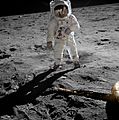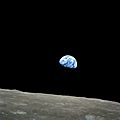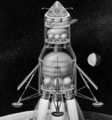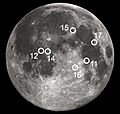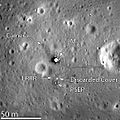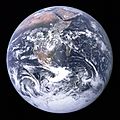Apollo program facts for kids
 |
|
| Country | United States |
|---|---|
| Organization | NASA |
| Purpose | Crewed lunar landing |
| Status | Completed |
| Program history | |
| Cost | $25.4 billion (1973) |
| Duration | 1961–1972 |
| First flight |
|
| First crewed flight |
|
| Last flight |
|
| Successes | 32 |
| Failures | 2 (Apollo 1 and 13) |
| Partial failures | 1 (Apollo 6) |
| Launch site(s) |
|
| Vehicle information | |
| Crewed vehicle(s) | |
| Launch vehicle(s) | |
The Apollo program was a big project by the United States' space agency, NASA. Its main goal was to send humans to the Moon and bring them back safely to Earth. US President John F. Kennedy started the program in 1961. He believed it was important for the United States to lead in space exploration.
President Kennedy said:
Now it is time to take longer - time for a great new American enterprise - time for this nation to take a clearly leading role in space achievement, which in many ways may hold the key to our future on Earth.
...I believe that this nation should commit itself to achieving the goal, before this decade is out, of landing a man on the Moon and returning him safely to the Earth. No single space project in this period will be more important to mankind, or more important in the exploration of space; and none will be so difficult or expensive to accomplish. Full text
One big reason for starting the Apollo program was the "Space Race." This was a competition between the United States and the Soviet Union during the Cold War. The Soviet Union was the first to send a person into outer space. The US wanted to show it could also achieve great things in space.
The Apollo spacecraft had two main parts that traveled to the Moon:
- The Command and Service Module (CSM) was the main spaceship. It was the only part that returned to Earth.
- The Lunar Module (LM) was the lander. It carried astronauts down to the Moon's surface.
These parts connected in space. Earlier spaceships like Mercury and Gemini were very small. The Apollo capsule was much bigger, allowing astronauts to move around. The Lunar Module was also roomy inside. After the astronauts left the Moon, the Lunar Module would be left behind.
The Apollo program officially ended in 1975. After that, NASA worked on other projects like the Space Shuttle, the International Space Station, and many robot missions to explore space.
You might have heard of the movie about the problems that happened during the Apollo 13 mission.
Contents
Apollo Mission Types
In 1967, NASA planned a series of Apollo missions. Each mission type had a special goal. They had to complete each step successfully before moving to the next. This plan helped them get ready to land a person on the Moon.
Here are the main types of missions:
- Type A – These were uncrewed flights to test the powerful Saturn V rocket and the Command/Service Module (CSM). Apollo 4 and Apollo 6 were Type A missions.
- Type B – These were uncrewed flights to test the Lunar Module (LM). Apollo 5 was a Type B mission.
- Type C – This was the first crewed mission. It tested the CSM in low Earth orbit. Apollo 7 was a Type C mission.
- Type D – These missions tested the CSM and LM together in low Earth orbit. Apollo 9 was a Type D mission.
- Type F – This was a "dress rehearsal" mission. The crew flew the CSM and LM around the Moon, practicing everything except the actual landing. Apollo 10 was a Type F mission.
- Type G – This was the big one! The first mission to land humans on the Moon. Apollo 11 was a Type G mission.
After the first landing, there were more advanced missions:
- Type H – These missions focused on precise landings and allowed astronauts to stay on the Moon for up to two days. They also included two "moonwalks" (Extra-Vehicular Activities). Apollo 12, Apollo 13 (planned), and Apollo 14 were Type H missions.
- Type J – These were longer missions, allowing astronauts to stay on the Moon for three days. They included three moonwalks and used a special vehicle called the Lunar rover to explore further. Apollo 15, Apollo 16, and Apollo 17 were Type J missions.
Apollo Flights
The Apollo spacecraft were launched into space by powerful Saturn I and Saturn V rockets.
Uncrewed Flights
- AS-101 (May 28, 1964): Tested the Command Module.
- AS-102 (September 18, 1964): Tested the Command Module.
- AS-103 (February 16, 1965): Tested the Command Module and carried a Pegasus satellite.
- AS-104 (May 25, 1965): Tested the Command Module and carried a Pegasus satellite.
- AS-105 (July 30, 1965): Tested the Command Module and carried a Pegasus satellite.
- AS-201 (February 26, 1966): Tested the Command Module.
- AS-202 (August 25, 1966): Tested the Command Module.
- Apollo 4 (November 9, 1967): Tested the Command Module.
- Apollo 5 (January 22, 1968): Tested the Lunar Module.
- Apollo 6 (April 4, 1968): This was the last flight to check all the systems before crewed missions.
Crewed Flights
- Apollo 1 (January 27, 1967): During a training exercise, a fire broke out in the spacecraft. Sadly, three astronauts, Edward White, Gus Grissom, and Roger Chaffee, lost their lives. This tragedy led to important safety changes.
- Apollo 7 (October 11, 1968): This was the first flight with a crew: Wally Schirra, Donn Eisele, and Walter Cunningham. They orbited the Earth for several days, testing the Command Module.
- Apollo 8 (December 21, 1968): The crew, Frank Borman, Jim Lovell, and William Anders, were the first astronauts to orbit the Moon.
- Apollo 9 (March 9, 1969): The crew, James McDivitt, David Scott, and Russell Schweickart, tested the Lunar Module in Earth orbit. They also practiced connecting it with the Command Module.
- Apollo 10 (May 18, 1969): This mission carried all the equipment for a Moon landing. The crew, Thomas Stafford, John Young, and Eugene Cernan, studied possible landing sites while orbiting the Moon.
- Apollo 11 (July 16, 1969): This was the historic first mission to land humans on the Moon! Astronauts Neil Armstrong and Buzz Aldrin landed on July 20, 1969. Michael Collins stayed in orbit in the Command Module.
- Apollo 12 (November 14, 1969): The second team to land on the Moon was Pete Conrad and Alan Bean (November 19, 1969). They collected Moon rocks and looked at the Surveyor 3 spacecraft that had landed earlier. Richard Gordon stayed in orbit.
- Apollo 13 (April 11, 1970): An explosion in an oxygen tank nearly caused a disaster for the three astronauts: Jim Lovell, Jack Swigert, and Fred Haise. Thanks to quick thinking and teamwork, they made emergency repairs and returned safely to Earth.
- Apollo 14 (January 31, 1971): On February 5, 1971, astronauts Alan Shepard and Edgar Mitchell became the third group to land on the Moon. They collected rocks and did experiments. Stuart Roosa stayed in orbit.
- Apollo 15 (July 26, 1971): This mission continued collecting samples and doing experiments. David Scott and James Irwin landed on the Moon on July 30, 1971. Alfred Worden stayed in orbit.
- Apollo 16 (April 16, 1972): John Young and Charles Duke landed on the Moon on April 21, 1972. Ken Mattingly stayed in orbit.
- Apollo 17 (December 7, 1972): This was the final Moon visit, landing on December 11, 1972. It was special because it was the first to include a scientist, Harrison Schmitt, along with astronaut Eugene Cernan. Ronald Evans stayed in orbit.
- Skylab 2 (May 25, 1973): Pete Conrad, Paul Weitz, and Joseph Kerwin were the first crew to live on the Skylab space station.
- Skylab 3 (July 28, 1973): Alan Bean, Jack Lousma, and Owen Garriott were the second crew of the Skylab space station.
- Skylab 4 (November 16, 1973): Gerald Carr, William Pogue, and Edward Gibson were the last crew of the Skylab space station.
- Apollo-Soyuz (July 15, 1975): This was the very last mission using an Apollo spacecraft. It was a special joint mission with the Soviet Union.
See Also
Images for kids
-
Buzz Aldrin (pictured) walked on the Moon with Neil Armstrong, on Apollo 11, July 20–21, 1969.
-
Earthrise, the iconic 1968 image from Apollo 8 taken by astronaut William Anders
-
George Mueller, Wernher von Braun, and Eberhard Rees watch the AS-101 launch from the firing room
-
John Houbolt explaining the LOR concept
-
An Apollo boilerplate command module is on exhibit in the Meteor Crater Visitor Center in Winslow, Arizona.
-
Apollo 11 Lunar Module Eagle on the Moon, photographed by Neil Armstrong
-
A Saturn IB rocket launches Apollo 7, 1968
-
A Saturn V rocket launches Apollo 11, 1969
-
Apollo 1 crew: Ed White, command pilot Gus Grissom, and Roger Chaffee
-
Neil Armstrong descends the LM's ladder in preparation for the first steps on the lunar surface, as televised live on July 20, 1969
-
Lunar Roving Vehicle used on Apollos 15–17
-
Plaque left on the Moon by Apollo 17
-
The Blue Marble photograph taken on December 7, 1972, during Apollo 17. "We went to explore the Moon, and in fact discovered the Earth." —Eugene Cernan
-
Extraction The CMP docks the CSM with the LM, and pulls the complete spacecraft away from the S-IVB. The lunar voyage takes between two and three days. Midcourse corrections are made as necessary using the SM engine.
-
Lunar orbit insertion The spacecraft passes about 60 nautical miles (110 km) behind the Moon, and the SM engine is fired to slow the spacecraft and put it into a 60-by-170-nautical-mile (110 by 310 km) orbit, which is soon circularized at 60 nautical miles by a second burn.
-
After a rest period, the commander (CDR) and lunar module pilot (LMP) move to the LM, power up its systems, and deploy the landing gear. The CSM and LM separate; the CMP visually inspects the LM, then the LM crew move a safe distance away and fire the descent engine for Descent orbit insertion, which takes it to a perilune of about 50,000 feet (15 km).
-
The CDR and LMP perform one or more EVAs exploring the lunar surface and collecting samples, alternating with rest periods.
-
The ascent stage lifts off, using the descent stage as a launching pad.
-
Parachutes are deployed, slowing the CM for a splashdown in the Pacific Ocean. The astronauts are recovered and brought to an aircraft carrier.
See also
 In Spanish: Programa Apolo para niños
In Spanish: Programa Apolo para niños


